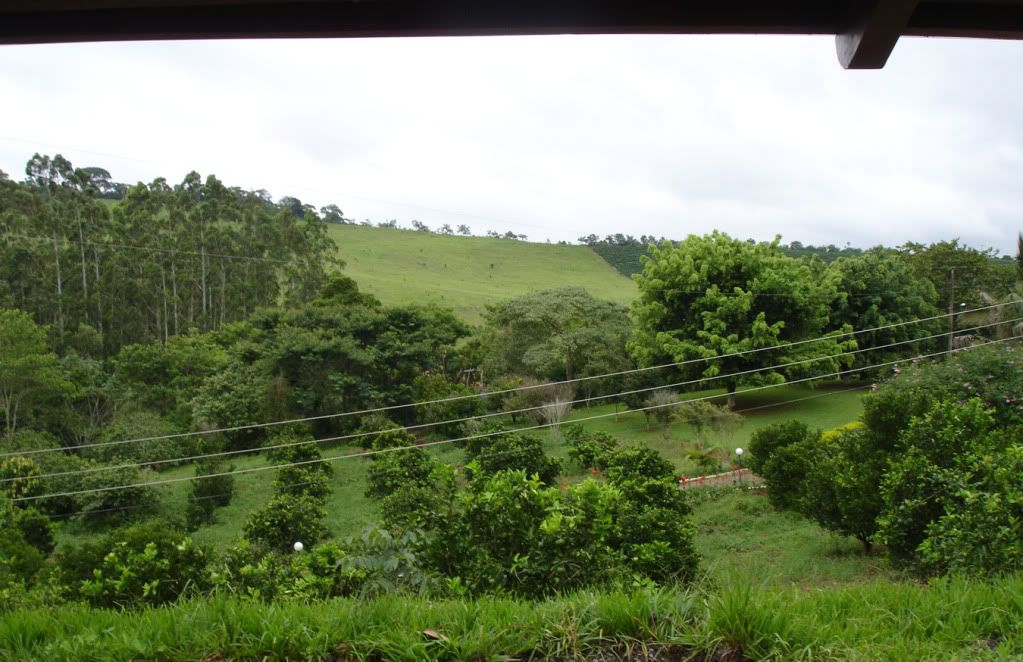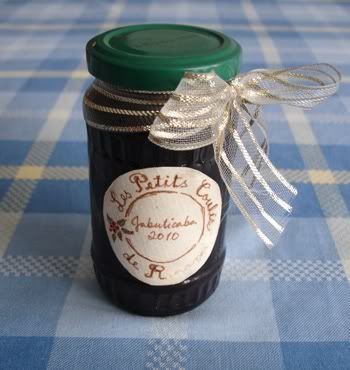Friday, January 21, 2011
Improvisation sur les Folies d'Espagne
From the film I saw some time ago, Tous le Marins du Monde.
Improvisation sur les Folies d'Espagne, Marin Marais (1656-1728)
Soundtrack played by Jordi Savall
And here, Jordi Savall
From Wikipedia, Folia:
La Folía (Spanish), also folies d'Espagne (French), Follies of Spain (English) or Follia (Italian), is one of the oldest remembered[citation needed] European musical themes, or primary material, generally melodic, of a composition, on record.
...
History
The epithet 'Folia' has several meanings in music.
Over the course of three centuries, more than 150 composers have used it in their works. The first publications of this theme date from the middle of the 17th century, but it is probably much older. Plays of the renaissance theatre in Portugal, including works by Gil Vicente, mention the folia as a dance performed by shepherds or peasants. The Portuguese origin is recorded in the 1577 treatise De musica libri septem by Francisco de Salinas.
Jean-Baptiste Lully, along with Philidor l'aîné[8] in 1672, Arcangelo Corelli in 1700, Marin Marais in 1701, Alessandro Scarlatti in 1710, Antonio Vivaldi in his Opus 1 No 12 of 1705, Francesco Geminiani in his Concerto Grosso Number 12 (which was, in fact, part of a collection of direct transcriptions of Corelli's violin sonatas), George Frederick Handel in the Sarabande of his Keyboard Suite in D minor HWV 437 of 1727, and Johann Sebastian Bach in his Peasants' Cantata of 1742 are considered to highlight this 'later' folia repeating theme in a brilliant way. Antonio Salieri's 26 variations, produced late in his career, are among his finest works.
In the 19th century, Franz Liszt included a version of the Folia in his Rhapsodie Espagnole, and Ludwig van Beethoven quoted it briefly in the second movement of his Fifth Symphony.[dubious – discuss]
La Folia once again regained composers' interest during the 1930s with Sergei Rachmaninov in his Variations on a theme by Corelli in 1931 and Manuel María Ponce and his Variations on "Spanish Folia" and Fugue for guitar.
The folia melody has also influenced Scandinavian folk music. It is said[who?] that around half of the old Swedish tunes are based on la folia. It is possible to recognize a common structure in many Swedish folk tunes, and it is similar to the folia structure. Old folk tunes (19th century or older) which do not have this structure often come from parts of Sweden with little influences from upper classes or other countries.
Improvisation sur les Folies d'Espagne, Marin Marais (1656-1728)
Soundtrack played by Jordi Savall
And here, Jordi Savall
From Wikipedia, Folia:
La Folía (Spanish), also folies d'Espagne (French), Follies of Spain (English) or Follia (Italian), is one of the oldest remembered[citation needed] European musical themes, or primary material, generally melodic, of a composition, on record.
...
History
The epithet 'Folia' has several meanings in music.
- Western classical music features both an "early Folia," which can take different shapes, and the better-known "later Folia" (also known as "Follia" with double l in Italy, "Folies d'Espagne" in France, and "Faronel's Ground" in England).
- "Early Folia": Recent research suggests that the origin of the folia framework lies in the application of a specific compositional and improvisational method to simple melodies in minor mode. Thus, the essence of the "early Folia" was not a specific theme or a fixed sequence of chords but rather a compositional-improvisational process which could generate these sequences of chords.[3]
- The "later Folia" is a standard chord progression (i-V-i-VII / III-VII-[i or VI]-V / i-V-i-VII / III-VII-[i or VI7]-V[4-3sus]-i) and usually features a standard or "stock" melody line, a slow sarabande in triple meter, as its initial theme. This theme generally appears at the start and end of a given "Folia" composition, serving as "bookends" for a set of variations within which both the melodic line and even the meter may vary. In turn, written variations on the "later Folia" may give way to sections consisting of partial or pure improvisation similar to those frequently encountered in the twelve-bar blues that rose to prominence in the twentieth century.
- Several sources report that Jean-Baptiste Lully was the first composer to formalize the standard chord progression and melodic line.[4][5]
- Other sources note that the chord progression eventually associated with the "later Folia" appeared in musical sources almost a century before the first documented use of the "Folia" name. The progression emerged between the end of the 15th century and the beginning of the 16th century in vocal repertory found in both Italian (“Canzoniere di Montecassino”, “Canzoniere di Perugia” and in the frottola repertoire) and Spanish sources (mainly in the “Cancionero Musical de Palacio” and, some years later, in the ensaladas repertoire). Even though the folía framework appeared almost at the same time in different countries with numerous variants that share similar structural features, it is not possible to establish in which country the framework originated.
- There exists a folk tune with the name "Folía" in the Canary Islands.[citation needed][clarification needed]
Over the course of three centuries, more than 150 composers have used it in their works. The first publications of this theme date from the middle of the 17th century, but it is probably much older. Plays of the renaissance theatre in Portugal, including works by Gil Vicente, mention the folia as a dance performed by shepherds or peasants. The Portuguese origin is recorded in the 1577 treatise De musica libri septem by Francisco de Salinas.
Jean-Baptiste Lully, along with Philidor l'aîné[8] in 1672, Arcangelo Corelli in 1700, Marin Marais in 1701, Alessandro Scarlatti in 1710, Antonio Vivaldi in his Opus 1 No 12 of 1705, Francesco Geminiani in his Concerto Grosso Number 12 (which was, in fact, part of a collection of direct transcriptions of Corelli's violin sonatas), George Frederick Handel in the Sarabande of his Keyboard Suite in D minor HWV 437 of 1727, and Johann Sebastian Bach in his Peasants' Cantata of 1742 are considered to highlight this 'later' folia repeating theme in a brilliant way. Antonio Salieri's 26 variations, produced late in his career, are among his finest works.
In the 19th century, Franz Liszt included a version of the Folia in his Rhapsodie Espagnole, and Ludwig van Beethoven quoted it briefly in the second movement of his Fifth Symphony.[dubious – discuss]
La Folia once again regained composers' interest during the 1930s with Sergei Rachmaninov in his Variations on a theme by Corelli in 1931 and Manuel María Ponce and his Variations on "Spanish Folia" and Fugue for guitar.
The folia melody has also influenced Scandinavian folk music. It is said[who?] that around half of the old Swedish tunes are based on la folia. It is possible to recognize a common structure in many Swedish folk tunes, and it is similar to the folia structure. Old folk tunes (19th century or older) which do not have this structure often come from parts of Sweden with little influences from upper classes or other countries.
 |
|
| Problems listening to this file? See media help. | |
Thursday, January 20, 2011
Wednesday, January 19, 2011
Compassion on Creativity
Rereading, again, and loving it even more every time, Eat, Pray, Love.
Elizabeth Gilbert writes directly to my heart and doubts, and in such a funny, warm, kind way.
Found this on Youtube, and being an artist, it is especially suitable.
Elizabeth Gilbert writes directly to my heart and doubts, and in such a funny, warm, kind way.
Found this on Youtube, and being an artist, it is especially suitable.
Thursday, January 06, 2011
The Last of Christmas
Today is Reis Magos/Epiphany, the day to take down the Christmas decorations.
Amazingly, I actually managed to!
The last few days I've been enjoying the lighted tree, the Christmas votive candles... the smell of the evergreen in my living room. As I was so late in setting up, the joy of seeing these was even greater. I was even a little sad, but a happy sad... another Christmas come and gone. Enjoyed, now that the rush&tiredness are over and just memory.
I'm awaiting some more photos that Son¹ took and has to send me. I'll post them here when they do come in...
The New Year we spent with some friends at their farm in the southeast part of the state, about three hours' drive away. We had a lovely time: very food oriented! What to cook, who(s) to cook it, the cooking, then the eating!
All repeated the next day!
This interspersed with good conversation and napping. I actually had to asked forgiveness from my hostess... I was taking very long naps; I think I may even have gotten some of my sleep debt paid!
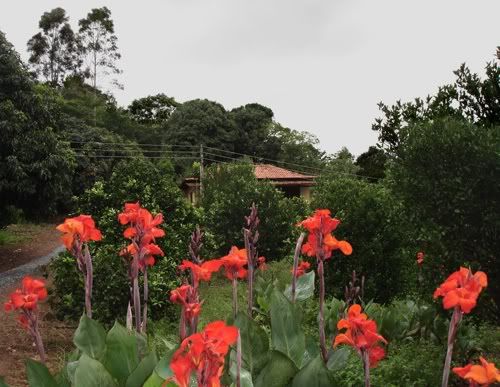

Hubby made a coulis of jaboticabas brought from Son² girlfriend's fazenda. This at the end of their season in November, but it has kept well in the fridge. Jaboticabas are a native fruit to our state, and the coulis has beautiful deep, dark reddish-violet color and a tart taste. It is especially beautiful over vanilla ice cream. Yumm!
I washed and boiled some small jars and put some of the coulis in one.
Then I made a quick label. The writing, made with a thin-tipped marker and color pencils, blurred as I had glued the label onto the jar with the very cold coulis already in it—the condensation attacked!
The effect came out not too bad... I can pretend it's a certain vintageness from ageing in a cellar.
I managed to find a ribbon in mymess atelier, and so, a gift for our hosts, who much admire Hubby's cooking talents.
Amazingly, I actually managed to!
The last few days I've been enjoying the lighted tree, the Christmas votive candles... the smell of the evergreen in my living room. As I was so late in setting up, the joy of seeing these was even greater. I was even a little sad, but a happy sad... another Christmas come and gone. Enjoyed, now that the rush&tiredness are over and just memory.
I'm awaiting some more photos that Son¹ took and has to send me. I'll post them here when they do come in...
The New Year we spent with some friends at their farm in the southeast part of the state, about three hours' drive away. We had a lovely time: very food oriented! What to cook, who(s) to cook it, the cooking, then the eating!
All repeated the next day!
This interspersed with good conversation and napping. I actually had to asked forgiveness from my hostess... I was taking very long naps; I think I may even have gotten some of my sleep debt paid!

The new little house, a guest cottage with two suites,
that we inaugurated. It is set up the hill in the orchard.
The materials were reused from another little house
that had been on the property.
that we inaugurated. It is set up the hill in the orchard.
The materials were reused from another little house
that had been on the property.
Click to enlarge
The view from the veranda of the guest cottage,
looking towards the valley.
The view from the veranda of the guest cottage,
looking towards the valley.
The red flowers' sisters that edge the drive can be seen.
The evening of January 1st we had...

Pizza!
A pizza fest in their home-pizzaria!
What a great way to start the new year!
What a great way to start the new year!
Sorry, what between sleepiness and pizza-hunger,
I didn't take pictures of the baked pizzas.
 |
| via |
I washed and boiled some small jars and put some of the coulis in one.
Then I made a quick label. The writing, made with a thin-tipped marker and color pencils, blurred as I had glued the label onto the jar with the very cold coulis already in it—the condensation attacked!
The effect came out not too bad... I can pretend it's a certain vintageness from ageing in a cellar.
I managed to find a ribbon in my
Monday, January 03, 2011
Christmas 2010
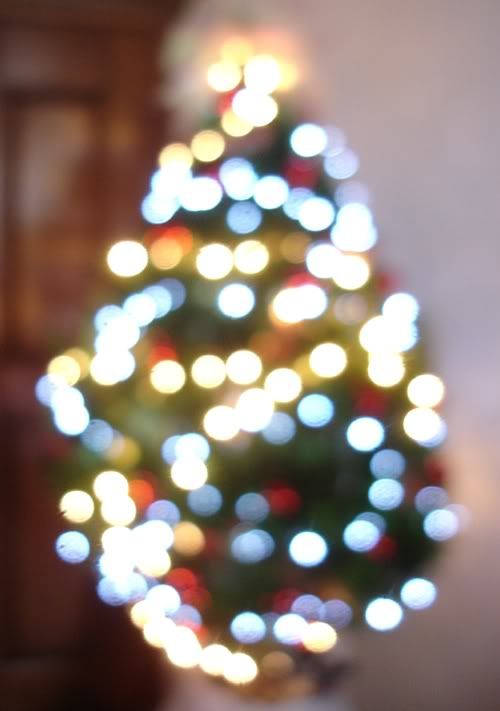
This year (last year!) I have to admit that I wasn't in too much of a Christmas mood.
I usually love setting out the decorations... getting out my family of stuffed animals that join us in our Christmas cheer, my tree decorations made and that survived the years, and twinkly lights for the tree and veranda.
This year, although I got the boxes out at the beginning of December, I finally managed to put the wreath on the door (the official start of Christmas for me) only a week and a half before Christmas eve. The tree, although bought a full week ahead, I was only able to get ready on morning of the 24th...
I guess this is the "Just in Time" planning so much touted about in the business world!
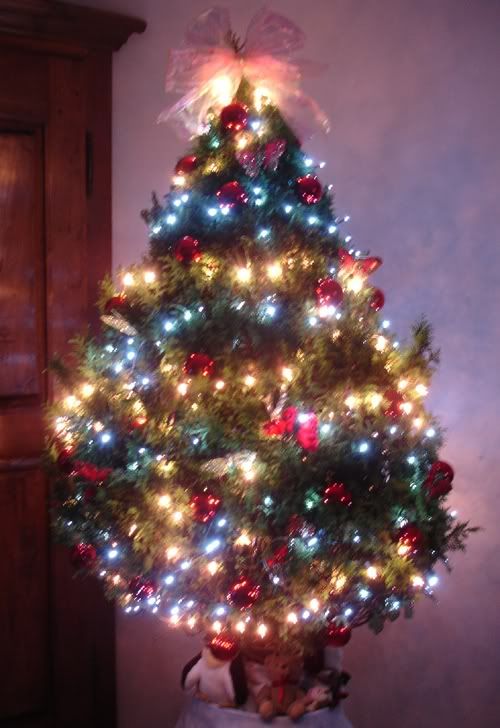
Hubby desired a live tree for Christmas this year, so we found this lovely little conical expensive thuya. The decorations were more in a minamalist mode: your basic lights&balls.
I used the survivors of various years' white incandescent mini lights, and a new set of unearthly (as in "alien/from another galaxy') white LED mini lights Hubbs brought back from his December trip to Germany. Yes, I do not like white LED lights...
But mixed, alternated, with the leftovers of the regular mini lights, it actually came out interesting... but just by themselves, just think Christmas at the Frankenstein's or something else rather creepy!
I added the red and green butterflies that Son²'s girlfriend gifted us and a bow of iridescent cellophane I made years and years ago, and ... voilá!
Nearly instant Christmas tree!
I then added the few animals I did find (the box with most if them I couldn't find... ??? where or where has my little
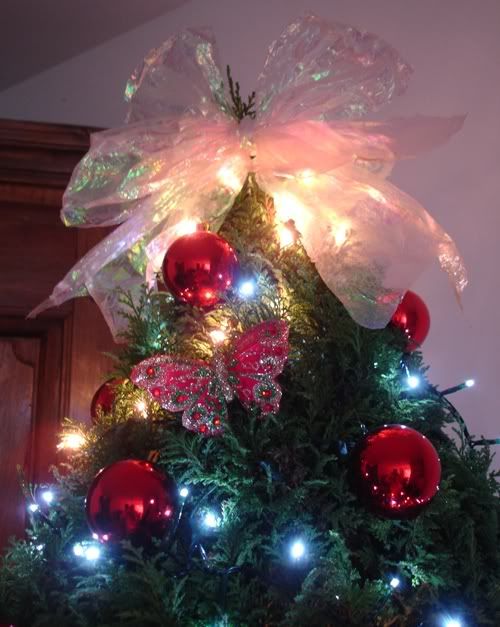
Although not to an auspicious start—actually a rather bad one with sleepless nights the whole week before due to my cold&coughing and some others troubles—the Christmas gatherings came out very well:
Christmas Eve dinner here at home and Christmas Day dinner that we cook and take to my mother's. The food was all delicious, and more importantly, everyone was happy and in good spirits.
All peacefull under the Christmas star!
Hubbs also brought back from Germany a green tablecloth and some red embroidery sousplats. Once out of the package while setting the table, I found out to my dismay that it was a rather garish, very shiny satin. Added to the red sousplats, the table came out veeery colorful, more than my usual style. But, honors to my dear Hubby for thinking of a pretty home!
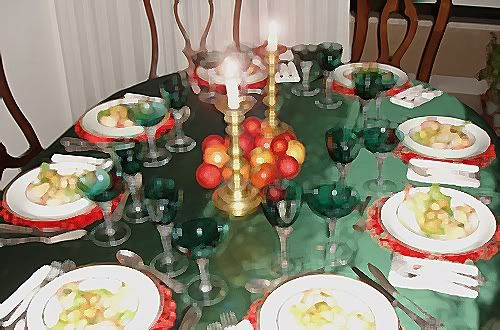
* Instant centerpiece: brass candlesticks plus apples plus red christmas balls *
I'll leave the Christmas dinner(s) menu(s) to another post.
Subscribe to:
Comments (Atom)
